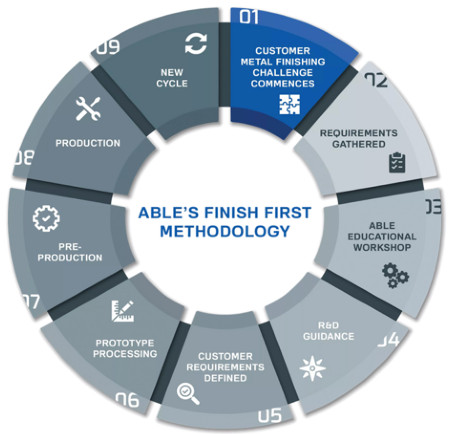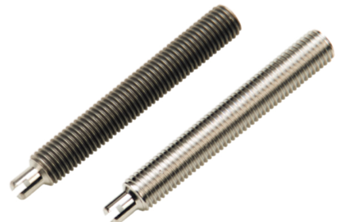There are a number of methods and technologies with which to affect the surface of a product. Each has its own set of advantages and best-use case scenarios. With medical devices, however, a surface finish that helps eliminate the chance of infection transmission is going to be particularly of interest. Eliminating micro-imperfections on a metal surface that can give a foothold to bacteria is critical.
Electropolishing is a process that eliminates a microscopic layer of material from the surface of a metal part. It leaves behind an exceptionally shiny surface, free of any flaws, pits, or rough edges. The finish also helps to eliminate the need for other processes to augment the surface of a part.
This surface finishing technology, while advantageous, requires an expert to achieve the best results. As such, we spoke with Pat Hayes, vice president of business development at Able Electropolishing Co., Inc., to gain a better understanding of the process and why its so favorable for medical device manufacturers specifically.
Sean Fenske: Can you please give an overview of what electropolishing is and how it works?
Pat Hayes: Electropolishing combines a rectified electrical current and a chemical bath to remove a microscopically precise layer of surface material from a wide variety of metal parts (removal controlled as low as ±0.0001 in., depending on the alloy and the application). Parts are fixed to a customized rack made of titanium, copper, or bronze and the rack is fixed to the positive side of the power source before being immersed in the chemical bath. The precision and consistency of results electropolishing provides makes it a preferred method for improving the fit, finish, and function of a wide variety of parts for medical devices, implants, and surgical tools.
The following video further explains the process.
Fenske: What are some of the most common problems medical manufacturers are seeking to remedy by specifying electropolishing for their critical metal parts?
Hayes: Cleanability and pathogen resistance are high on the list of benefits for medical manufacturers. Microburrs, microcracks, and other surface defects left behind in the machining process can create initiation sites for pathogen growth and corrosion, creating unacceptable risks that include the risk of part failure. Electropolishing leaves medical parts with a microsmooth surface finish that inhibits pathogen growth, aids in cleanability, and significantly improves corrosion resistance. Some medical manufacturers also like electropolishing for its ability to make extremely precise adjustments to part sizing for improved fit and function.
Fenske: How is the right amount of material removal determined?
Hayes: Depending on the material type and the application, electropolishing removes 0.0001 in. to 0.0015 in. of surface material per surface. The precise amount is determined in a process of engineering review and prototype electropolishing in close collaboration with our medical manufacturing clients.
As one example, microfinishing applications generally call for 0.0001 in. to 0.0005 in. per surface and can be controlled as precisely as ±0.0001 in.
Following are some general ranges of material removal for specific applications:
- Deburring: 0.0005 in. to 0.0015 in. removal per surface or as required per application
- Micro-Finishing: 0.0001 in. to 0.0005 in. removal per surface or as required per application
- Size/Weight/Dimension: Material removal to be determined for each application
- Endurance Finishing: 0.00025 in. to 0.0015 in. removal per surface or as required per application
- Decorative: Varies to accepted standard sample
- Bulk Electropolishing: Material removal varies resulting in a finish from bright to dull. The standards are based on sample approval.

Hayes: The prototyping stage is used to help manufacturing engineers anticipate any design issues that could impact finishing results. We run prototypes on full production equipment and provide consulting that ensures parts are optimally designed for high-quality finishing results. This process, which we call “Finish First,” is meticulous, and plays a role in ensuring the best fit, function, and finish of critical metal parts.
Fenske: What are some of the key benefits of using electropolishing for medical parts?
Hayes: In addition to the removal of surface contaminants and imperfections, electropolishing creates a passive, oxygen-rich surface that enhances resistance to corrosion and bacterial growth.

Before and after electropolishing to remove embedded contamination from the threads of a titanium medical part.
Electropolishing is compatible with a long list of metal alloys used in medical manufacturing, including specialty alloys like Nitinol and titanium.
For all of these reasons, electropolishing also leaves parts with superior biocompatibility. Our medical technical guide provides more detail around the sanitation, performance, and safety benefits of electropolishing that many medical manufacturers have come to rely upon.
| Benefits of Electropolishing for Medical Parts |
|---|
|
Hayes: We love working with medical manufacturers and design engineers. The level of innovation and sophistication the industry has achieved over the last decade is genuinely awe-inspiring and, since our process is so collaborative, it has driven innovation in our processes as well.
We have made a significant investment in robotic automation, vapor degreasing technology, training, and video-enhanced work instructions throughout our state-of-the-art facility, all of which has added a level of consistency and precision to our work that is unmatched in this industry.
Click here to learn more about Able Electropolishing Co., Inc. >>>>>













